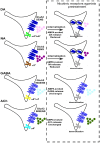Nicotinic modulation of glutamate receptor function at nerve terminal level: a fine-tuning of synaptic signals
- PMID: 25972809
- PMCID: PMC4413670
- DOI: 10.3389/fphar.2015.00089
Nicotinic modulation of glutamate receptor function at nerve terminal level: a fine-tuning of synaptic signals
Abstract
This review focuses on a specific interaction occurring between the nicotinic cholinergic receptors (nAChRs) and the glutamatergic receptors (GluRs) at the nerve endings level. We have employed synaptosomes in superfusion and supplemented and integrated our findings with data obtained using techniques from molecular biology and immuno-cytochemistry, and the assessment of receptor trafficking. In particular, we characterize the following: (1) the direct and unequivocal localization of native α-amino-3-hydroxy-5-methyl-4-isoxazolepropionic acid (AMPA) and N-methyl-D-aspartate (NMDA) glutamatergic receptors on specific nerve terminals, (2) their pharmacological characterization and functional co-localization with nAChRs on the same nerve endings, and (3) the existence of synergistic or antagonistic interactions among them. Indeed, in the rat nucleus accumbens (NAc), the function of some AMPA and NMDA receptors present on the dopaminergic and glutamatergic nerve terminals can be regulated negatively or positively in response to a brief activation of nAChRs. This effect occurs rapidly and involves the trafficking of AMPA and NMDA receptors. The event takes place also at very low concentrations of nicotine and involves the activation of several nAChRs subtypes. This dynamic control by cholinergic nicotinic system of glutamatergic NMDA and AMPA receptors might therefore represent an important neuronal presynaptic adaptation associated with nicotine administration. The understanding of the role of these nicotine-induced functional changes might open new and interesting perspectives both in terms of explaining the mechanisms that underlie some of the effects of nicotine addiction and in the development of new drugs for smoking cessation.
Keywords: AMPA receptors; NMDA receptors; neurotransmitter release; nicotinic receptors; receptor–receptor interactions; synaptic plasticity; synaptosomes.
Figures


Similar articles
-
Nicotinic receptors modulate the function of presynaptic AMPA receptors on glutamatergic nerve terminals in the trigeminal caudal nucleus.Neurochem Int. 2015 Nov;90:166-72. doi: 10.1016/j.neuint.2015.08.008. Epub 2015 Aug 12. Neurochem Int. 2015. PMID: 26277383
-
Prolonged nicotine exposure down-regulates presynaptic NMDA receptors in dopaminergic terminals of the rat nucleus accumbens.Neuropharmacology. 2014 Apr;79:488-97. doi: 10.1016/j.neuropharm.2013.12.014. Epub 2013 Dec 25. Neuropharmacology. 2014. PMID: 24373903
-
In vitro exposure to nicotine induces endocytosis of presynaptic AMPA receptors modulating dopamine release in rat nucleus accumbens nerve terminals.Neuropharmacology. 2012 Oct;63(5):916-26. doi: 10.1016/j.neuropharm.2012.06.049. Epub 2012 Jul 5. Neuropharmacology. 2012. PMID: 22771975
-
Modulatory role of presynaptic nicotinic receptors in synaptic and non-synaptic chemical communication in the central nervous system.Brain Res Brain Res Rev. 1999 Nov;30(3):219-35. doi: 10.1016/s0165-0173(99)00016-8. Brain Res Brain Res Rev. 1999. PMID: 10567725 Review.
-
Excitatory amino acids: function and significance in reproduction and neuroendocrine regulation.Front Neuroendocrinol. 1994 Mar;15(1):3-49. doi: 10.1006/frne.1994.1002. Front Neuroendocrinol. 1994. PMID: 7958168 Review.
Cited by
-
Presynaptic Release-Regulating mGlu1 Receptors in Central Nervous System.Front Pharmacol. 2016 Aug 31;7:295. doi: 10.3389/fphar.2016.00295. eCollection 2016. Front Pharmacol. 2016. PMID: 27630571 Free PMC article. Review.
-
Presynaptic mGlu1 Receptors Control GABAB Receptors in an Antagonist-Like Manner in Mouse Cortical GABAergic and Glutamatergic Nerve Endings.Front Mol Neurosci. 2018 Sep 18;11:324. doi: 10.3389/fnmol.2018.00324. eCollection 2018. Front Mol Neurosci. 2018. PMID: 30279647 Free PMC article.
-
Secreted Amyloid Precursor Protein-Alpha Promotes Arc Protein Synthesis in Hippocampal Neurons.Front Mol Neurosci. 2019 Aug 14;12:198. doi: 10.3389/fnmol.2019.00198. eCollection 2019. Front Mol Neurosci. 2019. PMID: 31474829 Free PMC article.
-
Does kynurenic acid act on nicotinic receptors? An assessment of the evidence.J Neurochem. 2020 Mar;152(6):627-649. doi: 10.1111/jnc.14907. Epub 2019 Nov 24. J Neurochem. 2020. PMID: 31693759 Free PMC article. Review.
-
Nicotinic receptors as SARS-CoV-2 spike co-receptors?Med Hypotheses. 2022 Jan;158:110741. doi: 10.1016/j.mehy.2021.110741. Epub 2021 Dec 14. Med Hypotheses. 2022. PMID: 34924680 Free PMC article.
References
-
- Akashi K., Kakizaki T., Kamiya H., Fukaya M., Yamasaki M., Abe M., et al. (2009). NMDA receptor GluN2B (GluRε2/NR2B) subunit is crucial for channel function, postsynaptic macromolecular organization, and actin cytoskeleton at hippocampal CA3 synapses. J. Neurosci. 29, 10869–10882. 10.1523/JNEUROSCI.5531-08.2009 - DOI - PMC - PubMed
Publication types
LinkOut - more resources
Full Text Sources
Other Literature Sources

